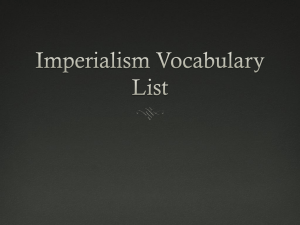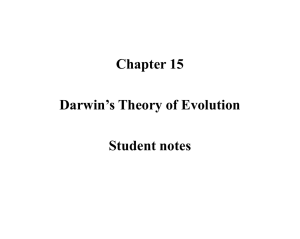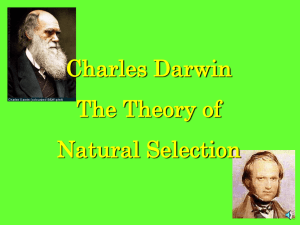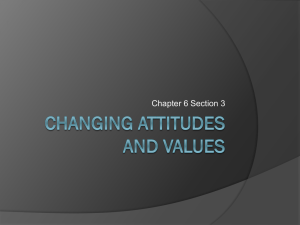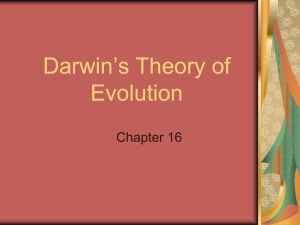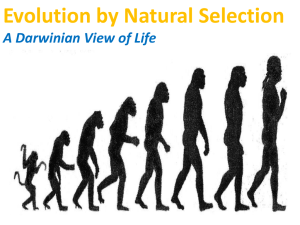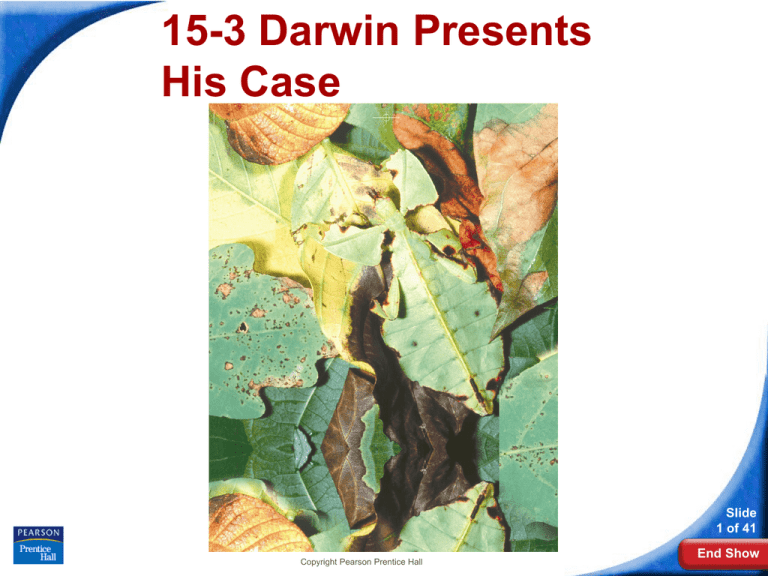
15-3 Darwin Presents
His Case
Slide
1 of 41
Copyright Pearson Prentice Hall
End Show
15-3 Darwin Presents His Case
Publication of On the Origin of
Species
Publication of On the Origin of Species
In his book, Darwin:
• proposed a mechanism for evolution called
natural selection.
• presented evidence that evolution has been
taking place for millions of years.
Slide
2 of 41
Copyright Pearson Prentice Hall
End Show
15-3 Darwin Presents His Case
Inherited Variation and Artificial
Selection
Inherited Variation and Artificial Selection
Members of each species vary from one another
Darwin noted that plant and animal breeders
would breed only the best organisms.
Darwin termed this process artificial selection.
Slide
3 of 41
Copyright Pearson Prentice Hall
End Show
15-3 Darwin Presents His Case
Inherited Variation and Artificial
Selection
Cauliflower
Brussels
Sprouts
Broccoli
Kohlrabi
Ancestral
Species
Kale
Copyright Pearson Prentice Hall
Slide
4 of 41
End Show
15-3 Darwin Presents His Case
Evolution by Natural Selection
Evolution by Natural Selection
Darwin compared processes in nature to artificial
selection.
He developed a hypothesis called Natural
Selection to explain how evolution occurs.
Slide
5 of 41
Copyright Pearson Prentice Hall
End Show
15-3 Darwin Presents His Case
Evolution by Natural Selection
The Struggle for Existence
High birth rates vs shortages of basic needs
would force organisms to compete for food,
shelter, etc…
Slide
6 of 41
Copyright Pearson Prentice Hall
End Show
15-3 Darwin Presents His Case
Evolution by Natural Selection
Survival of the Fittest
The ability of an individual to survive and
reproduce in its environment is fitness.
An adaptation is any inherited characteristic that
increases an organism's chance of survival.
Slide
7 of 41
Copyright Pearson Prentice Hall
End Show
15-3 Darwin Presents His Case
Evolution by Natural Selection
Individuals with characteristics that are not well suited
to their environment either die or leave few offspring.
Individuals that are better suited to their environment
survive and reproduce most successfully.
Darwin called this survival of the fittest.
Slide
8 of 41
Copyright Pearson Prentice Hall
End Show
15-3 Darwin Presents His Case
Evolution by Natural Selection
Over time, natural selection results in
changes in the characteristics of a
population.
These changes increase a species'
fitness in its environment.
Slide
9 of 41
Copyright Pearson Prentice Hall
End Show
15-3 Darwin Presents His Case
Evidence of Evolution
Evidence of Evolution
Darwin argued that living things have
been evolving on Earth for millions of
years.
Evidence includes:
fossil record, homologous structures,
and similarities in embryology.
Slide
10 of 41
Copyright Pearson Prentice Hall
End Show
15-3 Darwin Presents His Case
Evidence of Evolution
Similar, But Unrelated
Species
and
and
Slide
11 of 41
Copyright Pearson Prentice Hall
End Show
15-3 Darwin Presents His Case
Evidence of Evolution
Homologous Structures
Turtle
Alligator
Bird
Mammal
Ancient, lobefinned fish
Slide
12 of 41
Copyright Pearson Prentice Hall
End Show
15-3 Darwin Presents His Case
Evidence of Evolution
Similarities in Embryology
The embryos of many animals with backbones are
very similar.
The same groups of embryonic cells develop in the
same order to produce the tissues of all
vertebrates.
Slide
13 of 41
Copyright Pearson Prentice Hall
End Show
15-3 Darwin Presents His Case
Summary of Darwin's Theory
Summary of Darwin's Theory
Individual organisms differ.
Organisms produce more offspring than can
survive.
Organisms compete for limited resources.
Slide
14 of 41
Copyright Pearson Prentice Hall
End Show
15-3 Darwin Presents His Case
Summary of Darwin's Theory
Individuals best suited to their environment survive
and reproduce.
These organisms pass their heritable traits to their
offspring.
This process of natural selection causes species to
change over time.
Slide
15 of 41
Copyright Pearson Prentice Hall
End Show
15-3 Darwin Presents His Case
Summary of Darwin's Theory
Species alive today are descended from ancestors.
This process unites all organisms on Earth into a
single tree of life.
Slide
16 of 41
Copyright Pearson Prentice Hall
End Show
15-3
The scientist who motivated Darwin to publish
On the Origin of Species was
a. Alfred Russel Wallace.
b. Charles Lyell.
c. Jean-Baptiste Lamarck.
d. Thomas Malthus.
Slide
17 of 41
End Show
Copyright Pearson Prentice Hall
15-3
Differences among individuals of a single
species are referred to as
a. artificial selection.
b. genetic variation.
c. survival of the fittest.
d. environmental adaptation.
Slide
18 of 41
End Show
Copyright Pearson Prentice Hall
15-3
Changes that increase a species' fitness in its
environment over time are due to
a. the principle of common descent.
b. the geographic distribution of that species.
c. natural selection.
d. habitat selection.
Slide
19 of 41
End Show
Copyright Pearson Prentice Hall
15-3
An inherited characteristic that increases an
organism's chance of survival is called a(an)
a. homologous structure.
b. vestigial organ.
c. adaptation.
d. analogous structure.
Slide
20 of 41
End Show
Copyright Pearson Prentice Hall
15-3
Evidence used by Darwin to support the idea of
evolution included all the following EXCEPT
a. fossils that demonstrate change over time.
b. the genetic mechanism by which useful traits
are inherited.
c. the geographic distribution of living things.
d. the presence of many homologous
structures in plants and animals.
Slide
21 of 41
End Show
Copyright Pearson Prentice Hall




